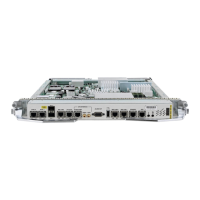Configuring the Satellite Network Virtualization (nV) System on the Cisco ASR 9000 Series Router
Implementing a Satellite nV System
HC-718
Cisco ASR 9000 Series Aggregation Services Router Interface and Hardware Component Configuration Guide
OL-26061-03
Configuring the Inter-Chassis Links and IP Connectivity
Inter-Chassis Links (ICLs) need to be explicitly configured, in order to indicate which satellite is
expected to be connected. You must also specify the access, that is down-stream GigE ports, which
crosslink up to the Host through the configured ICL. In order to establish connectivity between the host
and satellite, suitable IP addresses must be configured on both sides. The satellite IP address is
forwarded through the Discovery protocol. The configuration is described in the section, Defining the
Satellite nV System, page 714.
Note This configuration shows the use of the global default VRF. The recommended option is to use a private
VRF for nV IP addresses as shown in the Satellite Management using private VRF subsection under
Satellite System Configuration: Example.
SUMMARY STEPS
1. configure
2. interface <interface_name>
3. description To Sat5 1/46
4. ipv4 point-to-point
5. ipv4 unnumbered Loopback0
Step 3
ipv4 address
Example:
RP/0/RSP0/CPU0:router(config-int)# ipv4
address 8.8.8.8 255.255.255.255
Configures the host IP address on a loopback interface.
Step 4
end
or
commit
Example:
RP/0/RSP0/CPU0:router(config)# end
or
RP/0/RSP0/CPU0:router(config)# commit
Saves configuration changes.
• When you issue the end command, the system prompts you to
commit changes:
Uncommitted changes found, commit them before
exiting(yes/no/cancel)?
[cancel]:
–
Entering yes saves configuration changes to the running
configuration file, exits the configuration session, and
returns the router to EXEC mode.
–
Entering no exits the configuration session and returns the
router to EXEC mode without committing the
configuration changes.
–
Entering cancel leaves the router in the current
configuration session without exiting or committing the
configuration changes.
• Use the commit command to save the configuration changes to
the running configuration file and remain within the
configuration session.
Command or Action Purpose

